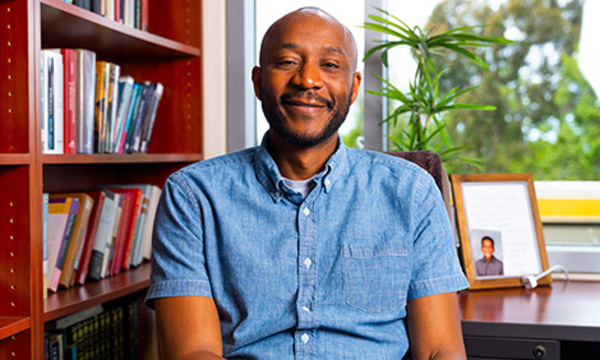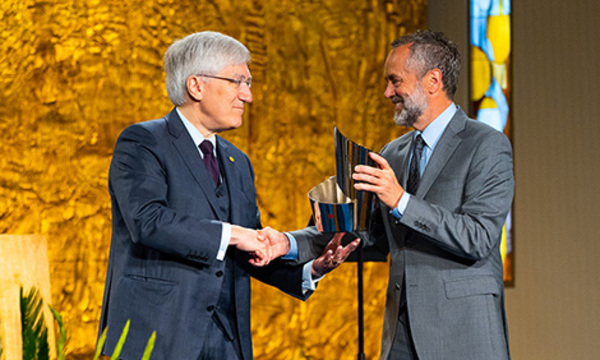
ÔÇ£I am not ashamed to own that I believe that the whole universe, heaven and earth, air and seas, the divine constitution and history of the holy Scriptures, be full of images of divine things." ÔÇô Jonathan Edwards
O Lord supreme, whose works so fair,
Sublime and varied, every where
The gazing eye delight!
Thy wisdom, power, and love, the day
Doth in its splendid course display,
As doth the glorious night.
ÔÇô Joanna Baillie
Eighteenth-century Puritan theologian Jonathan Edwards and 19th-century Presbyterian poet Joanna Baillie both reflect the ecclesiastical heritage of ¢±╚ı║┌┴¤ and both express the idea that nature, along with the Bible, conveys divine Truth (see also Psalm 19:1 and Romans 1:20). Together, Edwards and Baillie suggest that when we ignore the sublimity and beauty found in natural landscapes, or tread on them irreverently, bending natural resources to our own ends, we not only contribute to environmental degradation but also dishonor our Christian heritage.
As part of ¢±╚ı║┌┴¤ÔÇÖs Year of the Arts, I have organized a one-day symposium to take place on May 12, 2012, titled ÔÇ£Nature as Sacred Space.ÔÇØ The event will include a keynote address from Maire Mullins, editor of the journal Christianity and Literature and specialist in 19th-century American literature, as well as presentations from contributors to Fresh Landscapes of the Heart: Narratives of Nature and Community, an essay collection I edited in memory of my father, Michael Aleksiuk, a zoologist who taught me to look for evidence of the Creator in his creation. The essay contributors each share how nature has acted as a source of spiritual sustenance: providing hope in dark times, healing from past wounds, groundedness amidst difficult changes, and rejuvenation after burnout. They also speak of natureÔÇÖs power to bring about personal conviction, causing us to face the truth of ourselves in proper humility, which replaces conflict-seeking, confrontational bravado with problem-solving, co-operational openness. Written by poets and environmentalists, established biologists and students of spiritual formation, the essays themselves reflect a co-operative diversity.
Together the contributors to Fresh Landscapes decry modern disconnection between ourselves and our fellow creatures, between human beings and the environment, between minds, bodies and spirits. The search for truth, purity and integrity from within a fallen, corrupt, polluted world echoes through the volume. In a collaborative essay written with his brother and philosopher father, David Brook urges us to shift our gaze from what he terms ÔÇ£consumerist fantasiesÔÇØ so that we may ÔÇ£begin to explore the cultural, personal and spiritual history integral to our North American heritage.ÔÇØ This is especially edifying though difficult advice for those of us living in Southern California.
Another contributor, occupational therapist Bronwen Black, views nature as a ÔÇ£curative force that has often itself been victimizedÔÇØ (ÔÇ£Yellow Circle MoonÔÇØ). Can we see nature through Henri NouwenÔÇÖs view of the ÔÇ£wounded healer,ÔÇØ as Christ-like in its suffering? In his 1737 sermon ÔÇ£The Creation Groans under the Sins of the Wicked,ÔÇØ Jonathan Edwards directs his ire at those who subject ÔÇ£visible creationÔÇØ to their own greed and ÔÇ£Lusts,ÔÇØ bending it to the ÔÇ£purposes of sin.ÔÇØ Here, in Southern California, this is pressingly evident in the depletion of biodiversity within the Pacific. In ÔÇ£Keeping the Glass Bottom Boats Afloat: Reflections on a Catalina Island Childhood,ÔÇØ ¢±╚ı║┌┴¤ English professor Marc Malandra observes, ÔÇ£There is perhaps no greater indication that we have neglected our responsibility as stewards of the environment we have been blessed with than the condition of our oceans.ÔÇØ
So, what can we do to turn away from the rush and pull of materialist media and focus, in a careful and conscientious manner, on the suffering servant that is our natural environment? How can we act more like the Good Samaritan in attending to nature as wounded healer instead of passing by in hardened indifference? Yes, the Good Samaritan was responding to human wounding specifically, but in Matthew 12:1 and Luke 13:15, when challenged for healing on the Sabbath, Jesus drew direct parallels between the restoration of human health and the moral imperative to care for our fellow creatures.
The ÔÇ£Nature as Sacred SpaceÔÇØ symposium in May will encourage open, co-operative, problem-solving discussion around such questions, but much solid, biblical scholarship has been generated around these questions in recent years, and so I will end with two suggestions for further reading. Mark McReynolds, ¢±╚ı║┌┴¤ environmental science professor, states, ÔÇ£I particularly like Steven Bouma-Prediger's For the Beauty of the Earth (Baker 2010) that lists several solid reasons why Christians should be involved in creation care, ending with a motivation I find particularly appealing: gratitude. Out of thankfulness to God for all that we have been blessed with we take care of it.ÔÇØ Secondly, Christopher WrightÔÇÖs Old Testament Ethics for the People of God contains a chapter on ÔÇ£Ecology and the Earth,ÔÇØ within which Wright suggests we move away from ÔÇ£stewardshipÔÇØ in conceptualizing Christian approaches to environmentalism and embrace the alternative biblical image of a Shepherd King who oversees his creatures with ÔÇ£benevolent care.ÔÇØ
Natasha Duquette, an associate professor of English at ¢±╚ı║┌┴¤, is the editor of the forthcoming essay collection Fresh Landscapes of the Heart: Narratives of Nature and Community. She holds a Ph.D. from QueenÔÇÖs University.
 ¢±╚ı║┌┴¤
¢±╚ı║┌┴¤.jpg)

